When you think of breathtaking blossoms, you probably don’t consider bushes and shrubs. You might be surprised to learn several shrub species are known for their colorful flowers.
Shrubs are not quite trees and not quite low-growing plants, so they are a great in-between option for gardens and lawns. While some shrubs only display foliage, others boast beautiful swaths of eye-catching yellow blooms.
Below you will find a comprehensive list of seventeen different yellow flowering shrubs with pictures to help you identify them.
Bush Cinquefoil
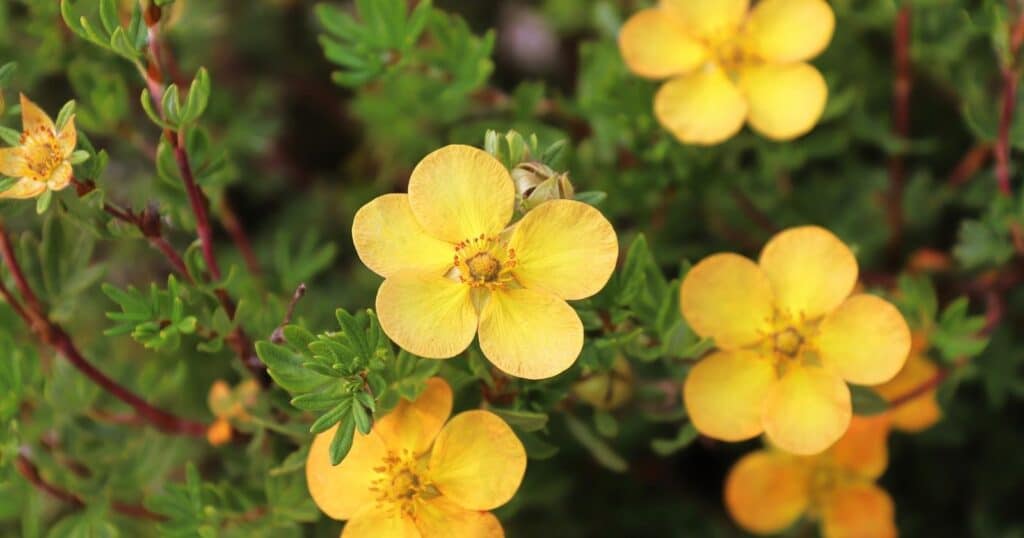
Scientific Name: Potentilla fruticosa
- Plant Type: Deciduous shrub
- Geographic Origin: Eurasia and North America
- Plant Size: 3 feet tall and 4 feet wide
- Sun Exposure: Full sun or partial shade
- Plant Zone: 2-8
Bush cinquefoil is native all across the Northern Hemisphere. It grows in mountain and meadow habitats. The plant’s unique name is derived from Latin. It means “five leaves” and refers to the number of leaflets found on many cinquefoils.
Usually, these shrubs produce one yellow flower, but some plants may sprout two flowers. The cinquefoil grows best in well-drained, fertile, moist soil. It will grow in dry, rocky, poor soils as well.
This member of the Rose family is easy to grow and has a strong resistance to both insects and diseases. It is a sturdy plant that can survive a wide range of growing conditions. They can thrive in salt ait, droughts, and stand up well to air pollution.
Though the bush cinquefoil is a hardy yellow flowering shrub, it is not suited for hot regions with humid summers. The yellow buds feature in homeopathic remedies for inflammation and digestion issues.
Bush Honeysuckle
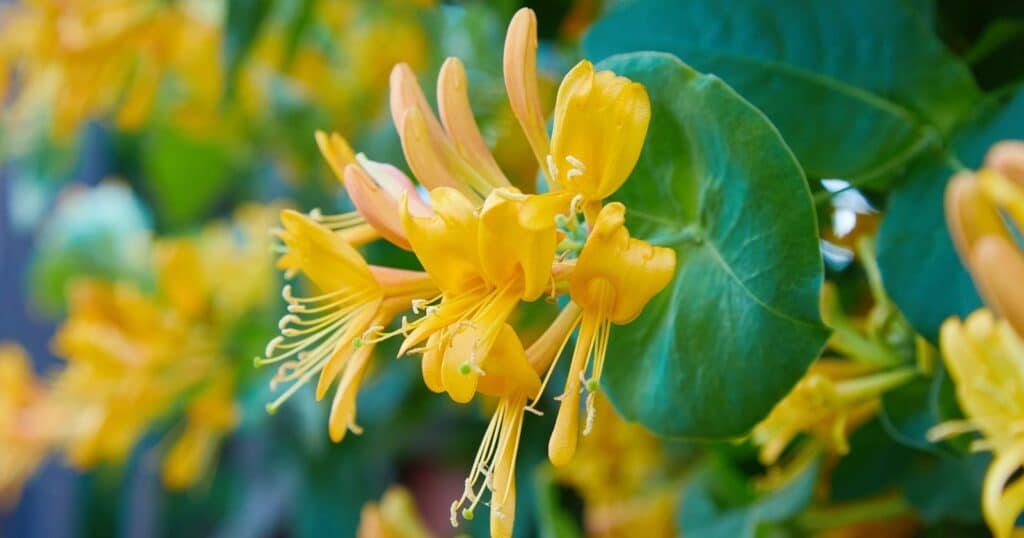
Scientific Name: Lonicera mackii
- Plant Type: Deciduous shrub
- Geographic Origin: Eurasia
- Plant Size: 3 feet tall and 4 feet wide
- Sun Exposure: Full sun
- Plant Zone: 3-10
You can find dozens of species of honeysuckle, but invasive species are referred to as bush honeysuckle. The leaves of the bush honeysuckle are green, oval-shaped, and one to three inches long. These green leaves stay attached and remain green well into the late fall.
The shrub’s flowers change from white to yellow over time, and it also produces red berries. Its bark is grayish-brown and has broad ridges and grooves. The flowers are sweet-smelling and very fragrant. They attract hummingbirds, bumblebees, and butterflies.
Bush honeysuckle originated in Eurasia and was introduced to North America for erosion control, landscaping, and wildlife cover. It is an aggressive species that can quickly cover the understory of an entire woodland area.
It tolerates all sorts of growing conditions and habitats. This hearty shrub will take root almost anywhere that birds can fly. Bush honeysuckle berries taste bitter and mildly toxic to humans.
Forsythia
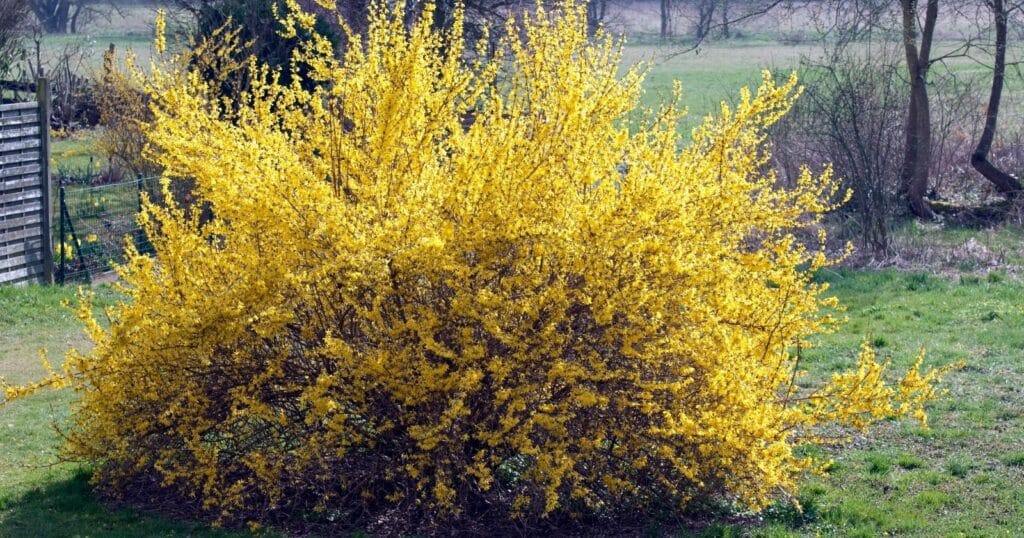
Scientific Name: Forsythia intermedia
- Plant Type: Deciduous shrub
- Geographic Origin: Asia
- Plant Size: 8 to 10 feet tall and 10 to 12 feet wide
- Sun Exposure: Full sun
- Plant Zone: 5-9
The adaptable Forsythia is a yellow flowering bush that produces bright, bell-shaped flowers. These yellow flowers make their appearance in the spring. The flowers are also known as Golden Bells.
The shrub is resistant to Japanese beetles and doesn’t have any serious disease issues. It is easy to grow, and Forsythia is deer tolerant as well. Once you plant it, Forsythia grows rapidly and lives for a long time.
The shade of Forsythia’s yellow blossoms will vary from pale yellow to deep yellow, depending on the variety. This shrub will tolerate almost any soil condition, but it grows best in loose, well-drained soil.
Golden Trumpet
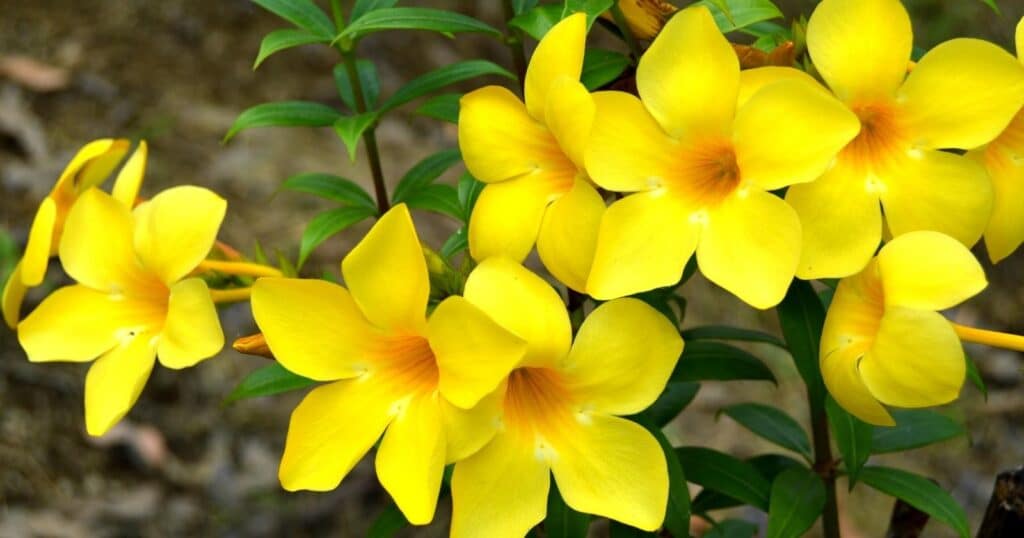
Scientific Name: Allamanda cathartica
- Plant Type: Evergreen tropical shrubby climber
- Geographic Origin: South America
- Plant Size: 10 to 20 feet tall and 3 to 6 feet wide
- Sun Exposure: Full sun
- Plant Zone: 10-11
Golden trumpets are often called common allamanda. The plant is a yellow flowering shrub used for ornamental landscaping in tropical climates. The large, fragrant blossoms are fragrant and boast a vivid golden color.
Common allamanda originated in South America, so it needs to be grown as a summer annual or in a hothouse in colder climates. Golden trumpets are not well suited as house plants due to their high humidity and light requirements.
Though the flowers are lovely to look at, the whole plant is mildly toxic to humans if ingested. In addition, the strong alkaloids in the sap can irritate the eyes and skin.
Honeycomb Butterfly Bush
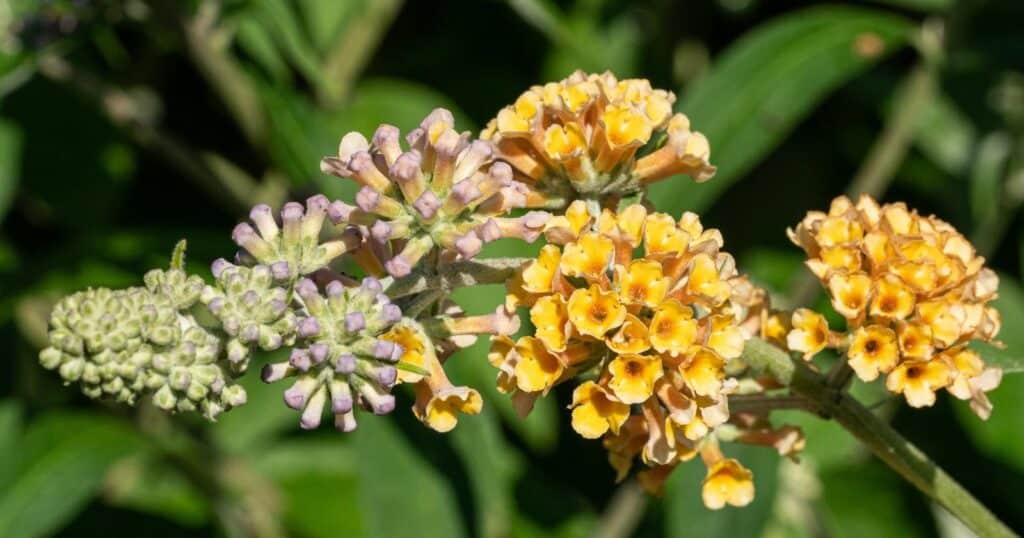
Scientific Name: Buddleja × weyeriana hybrid
- Plant Type: Deciduous shrub
- Geographic Origin: England
- Plant Size: 4 to 6 feet tall and 4 to 5 feet wide
- Sun Exposure: Full sun
- Plant Zone: 5-9
The aptly named Honeycomb Butterfly bush is a novel yellow flowering bush that has loads of summer blossoms that last well into the fall. Butterflies and hummingbirds are wild about these unique flowers and will flock to your lawns and gardens.
The Honeycomb butterfly bush is deer resistant and drought tolerant. It is a low-maintenance plant that will add color and fragrance to your corner of the world. The foliage has an elegant silver-green hue that works as a great background for the lush yellow flowers.
Japanese Rose Bush
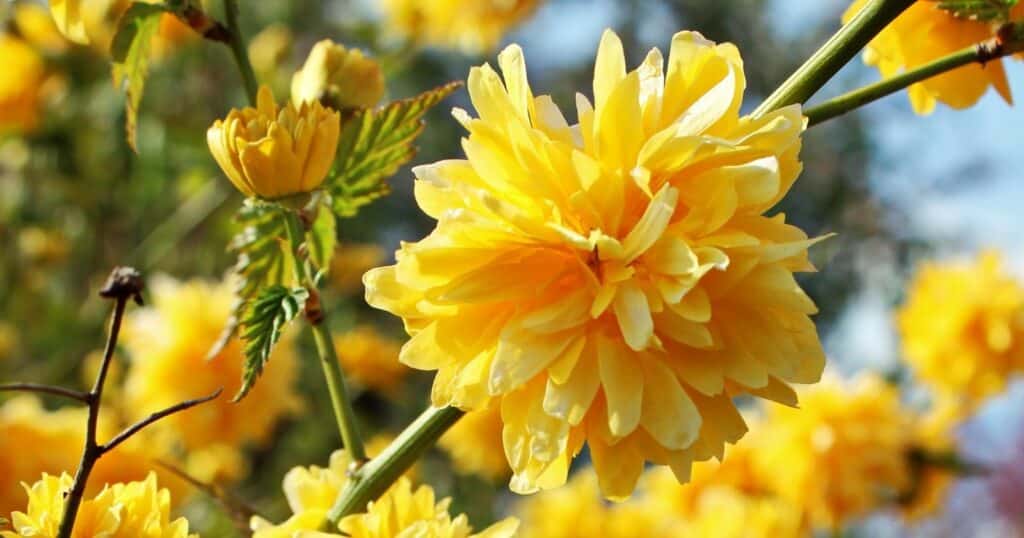
Scientific Name: Kerria japonica
- Plant Type: Deciduous shrub
- Geographic Origin: Eastern Asia
- Plant Size: 5 to 10 feet tall and 6 to 10 feet wide
- Sun Exposure: Partial sun or full shade
- Plant Zone: 4-9
Japanese rose bushes are versatile plants with arching stems and lots of yellow flowers that blossom in the springtime. In the fall, their green stems fade to yellow and provide a splash of color even when the temperatures drop below zero.
These yellow flowering bushes do not grow well in heavy clay but thrive in well-drained, moderately fertile soils. Japanese rose bushes will tolerate full sunlight in colder climates, though partial sun and full shade produce the best growth.
If the shrub is exposed to too much sunlight, the flowers fade quickly, and the foliage begins to look bleached. It is a drought-resistant plant that fares poorly in soggy soil. Japanese rose bushes are pretty tame in most climates, but they can become an invasive species in some regions.
Lydian Broom
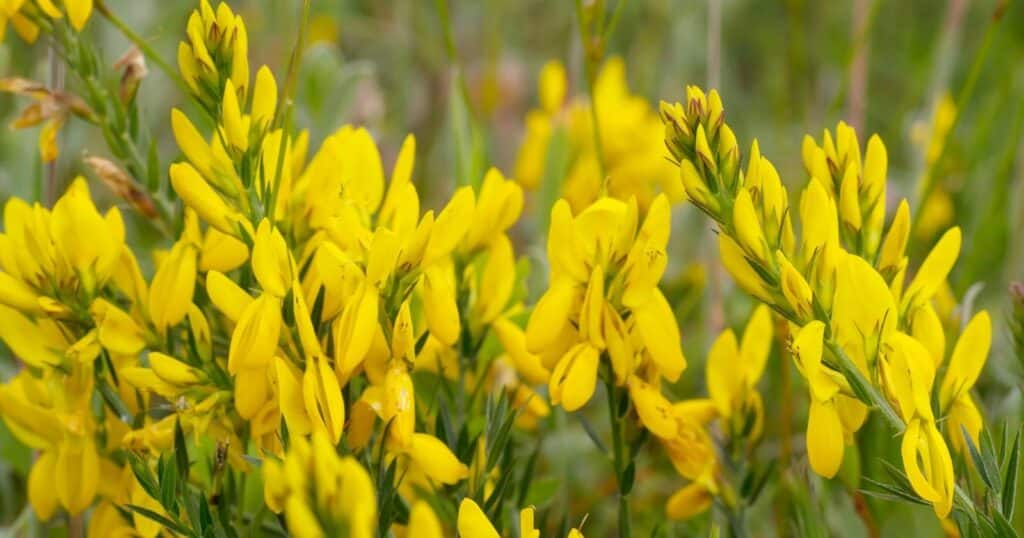
Scientific Name: Genista lydia
- Plant Type: Deciduous dwarf shrub
- Geographic Origin: The Balkans, Syria, Turkey
- Plant Size: 1 to 2 feet tall and wide
- Sun Exposure: Full sun
- Plant Zone: 4-9
Lydian broom is also called a common woadwaxen or dwarf broom. It is a multi-stemmed yellow flowering shrub that tends to hug the ground as it grows. Lydian broom has yellow pea-shaped flowers that bloom in mid to late spring.
The leaves are light green, and the plant is not aggressive to native foliage. It needs low fertility, well-drained soil, and full sun to grow. Lydia Broom is a perfect fit for dry, poor-quality soils. It is known to attract aphids but the Lydian broom is generally a disease-free plant.
Mahonia
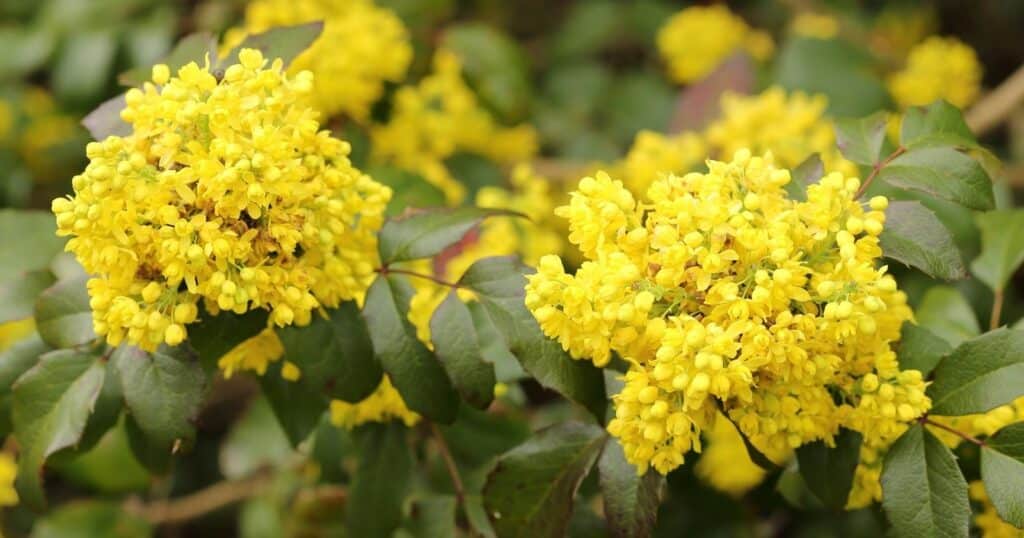
Scientific Name: Mahonia aquifolium
- Plant Type: Evergreen shrub
- Geographic Origin: Eastern Asia, North America, and Central America
- Plant Size: 7 feet tall and 7 to 10 feet wide
- Sun Exposure: Full sun or light shade
- Plant Zone: 6-8
Mahonia ushers in the springtime with its bright, fragrant flowers. It works great as a privacy barrier and makes a bold statement as an elegant yellow flowering shrub. It does best in moist soil and needs to be protected from the wind.
The shrub has glossy green leaves in an upright arrangement that lends a tropical vibe to this native woodland plant. Mahonia also boasts blue-black berried and sweet-smelling blossoms. These fragrant shrubs attract lots of bees, birds, and butterflies.
Moonshadow Wintercreeper
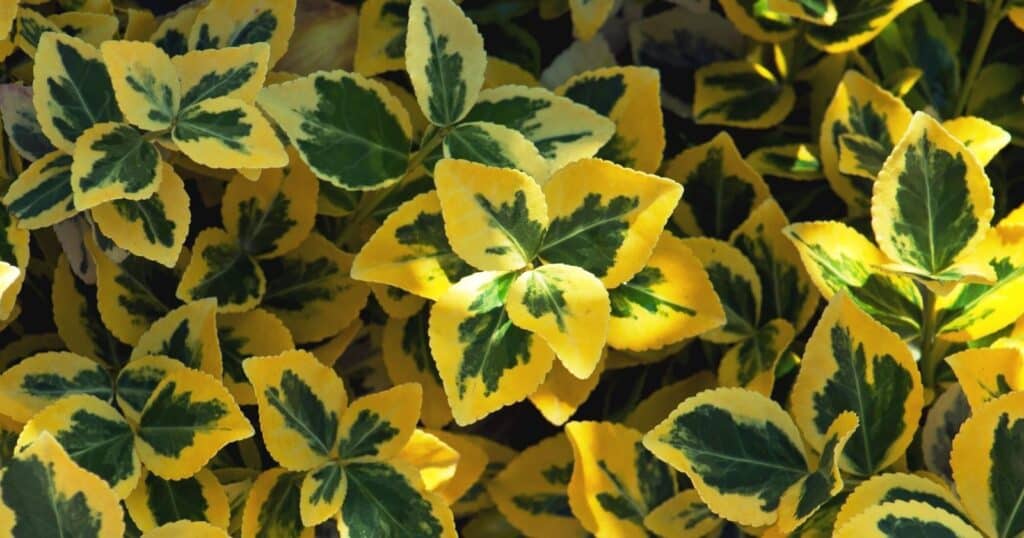
Scientific Name: Euonymus fortunei
- Plant Type: Evergreen shrub
- Geographic Origin: Asia, Japan, the Phillippines
- Plant Size: 1 to 2 feet tall and 3 to 4 feet wide
- Sun Exposure: Full sun or full shade
- Plant Zone: 5-9
The name might sound like something out of a fantasy novel, but the Moonshadow Wintercreeper is just a broadleaf evergreen shrub. Unlike most of the yellow flowering shrubs on this list, the Wintercreepers boasts yellow foliage.
The bright yellow leaves are just as eye-catching as any flower buds, and it contrasts well with other evergreen plants. This creates a head-turning landscaping effect for those who don’t like yellow blossoms. It is a versatile plant that is easy to grow. It has a moderately fast growth rate with compact, dense foliage.
St. John’s Wort
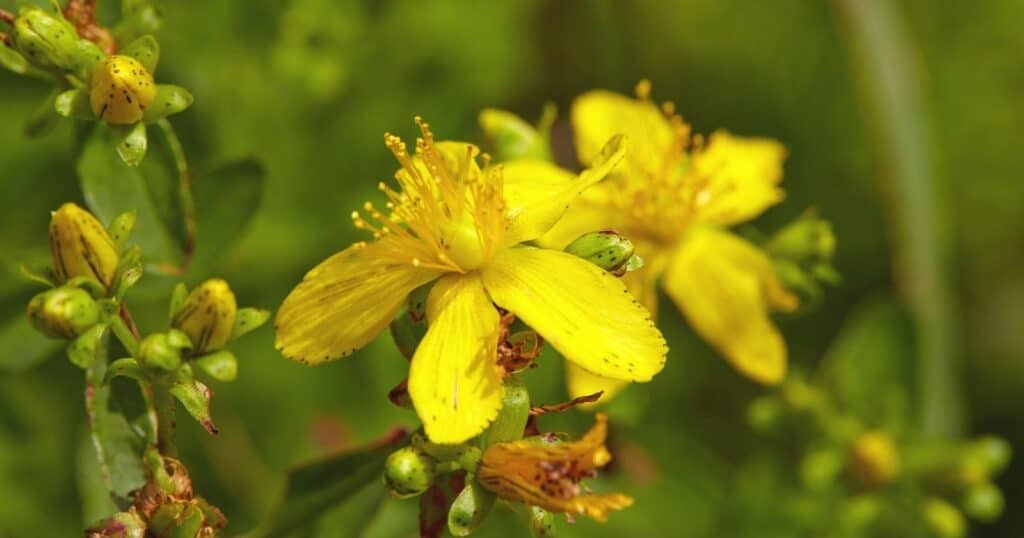
Scientific Name: Hypericum perforatum
- Plant Type: Semi-evergreen shrub
- Geographic Origin: Europe
- Plant Size: 1 to 3 feet tall and 1 to 2 feet wide
- Sun Exposure: Full sun or partial shade
- Plant Zone: 5-9
You may have heard of St. John’s wort before, as it has been used in homeopathic remedies since the time of the ancient Greeks. The plant is named after the Catholic Saint called John the Baptist because it blooms around his feast day in June.
This unassuming little yellow flowering shrub has blooms that last from midsummer to mid-fall. Once the flowers are gone, colorful berries replace them. It works well for ground cover and is an excellent soil stabilizer. Once the plant is established, it needs little to no care, making them an ideal addition to any landscape.
Witch Hazel
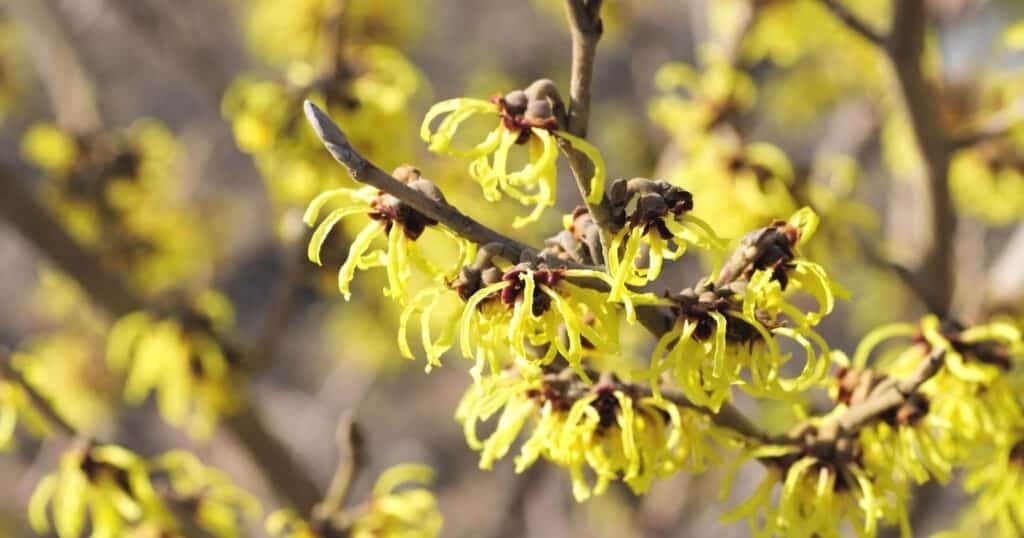
Scientific Name: Hamamelis
- Plant Type: Deciduous shrub
- Geographic Origin: North America
- Plant Size: 10 to 20 feet tall and 10 to 15 feet wide
- Sun Exposure: Full sun or filtered sun
- Plant Zone: 3-9
If you are looking for a hardy plant that provides some color to your winter landscape, look no further than the witch hazel shrub. In the fall and well into the winter, these fragrant shrubs produce spidery flowers that contrast beautifully with a sparkling winter backdrop.
Witch hazel is native to North America and was used by indigenous people for many medicinal purposes. Once it has been established in an area, this low-maintenance shrub should do just fine on its own.
Yellow Azaleas
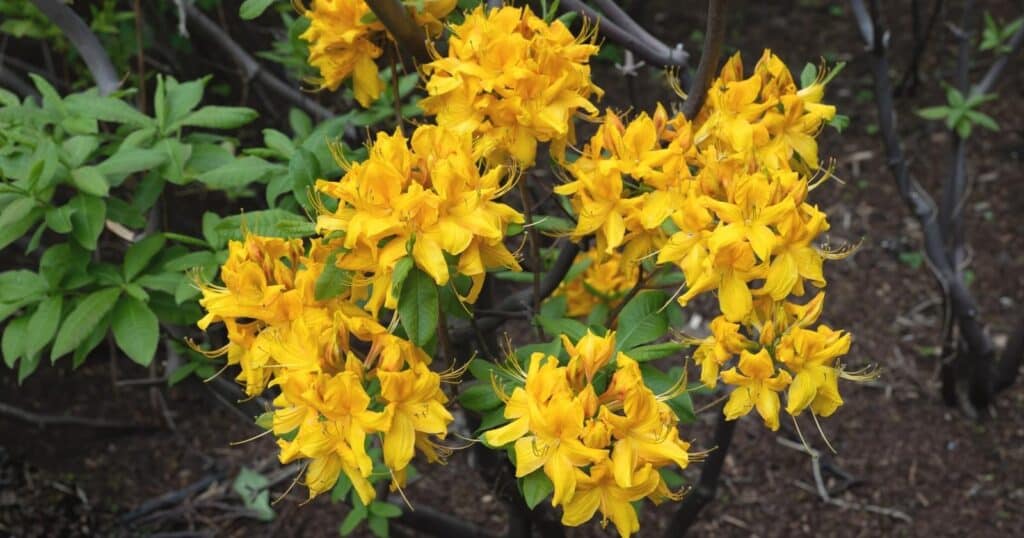
Scientific Name: Rhododendron luteum
- Plant Type: Deciduous flowering shrub
- Geographic Origin: Austria, Belarus, Poland, Turkey, Ukraine, and Yugoslavia
- Plant Size: 4 to 6 feet tall and 4 feet wide
- Sun Exposure: Full sun or partial shade
- Plant Zone: 6-9
Yellow azaleas are also known as honeysuckle Azaleas. These plants are some of the hardiest yellow flowering bushes and produce a treasure trove of golden yellow blossoms in the late spring and early summer.
The azalea flowers produce a sweet fragrance. They are yellow with a darker yellow blotch on the upper petals. The blooms first appear in May when the shrub’s new leaves begin to sprout.
Yellow azaleas attract butterflies and hummingbirds along with pests like nematodes, whiteflies, lace bugs, and aphids. In humans, the plant’s nectar can cause vomiting, mouth irritation, and nausea if ingested in small amounts.
Yellow Camellia
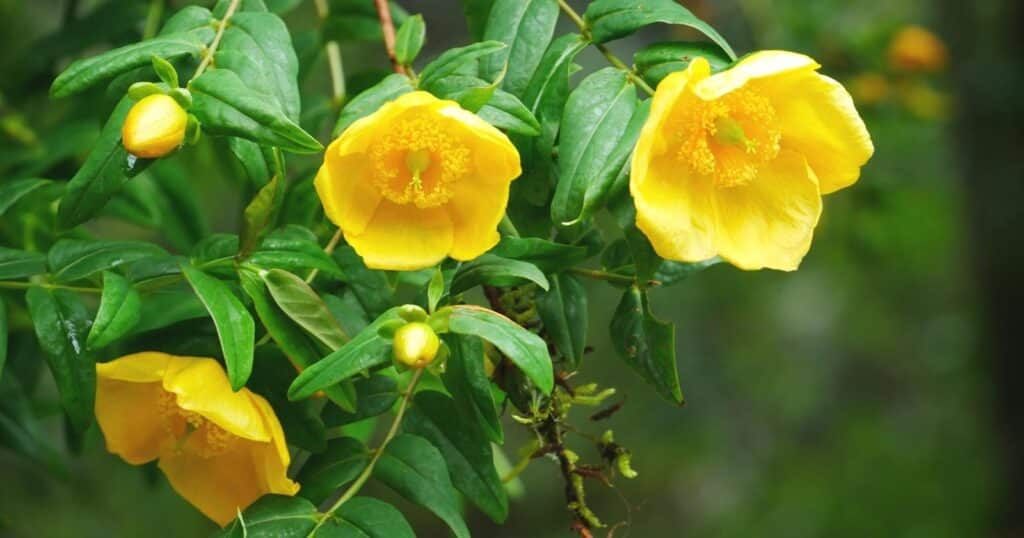
Scientific Name: Camellia nitidissima
- Plant Type: Evergreen shrub
- Geographic Origin: Eastern and southern Asia
- Plant Size: 8 to 12 feet tall and 5 to 7 feet tall
- Sun Exposure: Partial shade
- Plant Zone: 6-9
Yellow Camellia is a medium yellow flowering bush with white outer petals, golden stamens, and yellow petaloids.
It is an evergreen shrub that works well as a container plant or out in an open garden. The plant grows best in moist, well-drained soil or sandy, acidic soil with organic mulch. The shrub’s vibrant blossoms stand out against the deep green foliage and are a common sight in southern US gardens.
Once you get your yellow Camellia plant started, it needs very little maintenance and upkeep and will continue to bloom for years and years.
Yellow Hibiscus
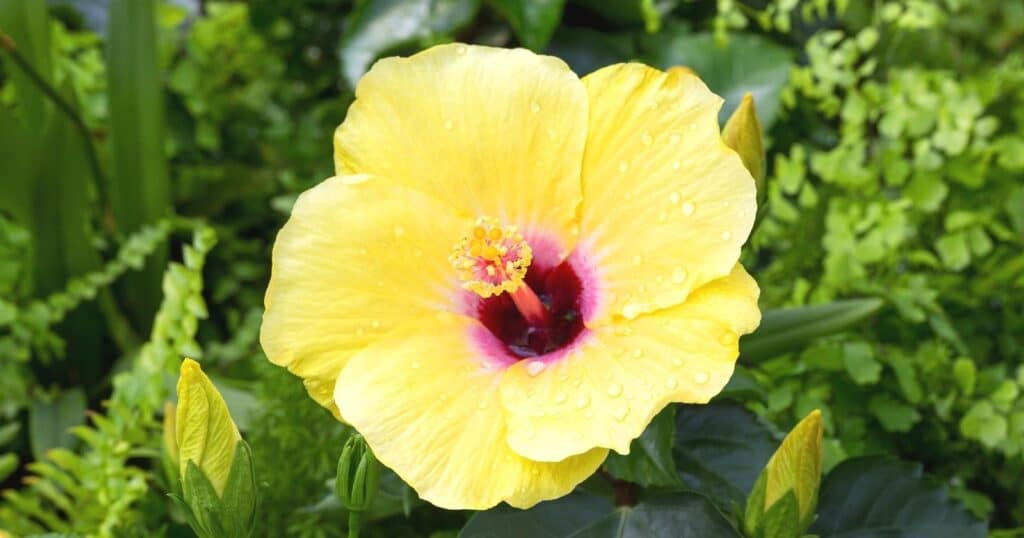
Scientific Name: Hibiscus brackenridgei
- Plant Type: Evergreen shrub
- Geographic Origin: Hawaii
- Plant Size: 2 to 6 feet tall and 8 to 10 feet wide
- Sun Exposure: Full sun or partial shade
- Plant Zone: 9-11
In 1988 the yellow hibiscus, also referred to as Pua Aloalo or Ma`o-hau-hele, was named the official state flower of Hawaii. This yellow flowering shrub is native to Hawaii, but it is an extremely rare plant that is considered an endangered species.
The large tropical blossoms provide a daring splash of vibrant color to any yard or garden, and they have a long blooming cycle.
Yellow hibiscus grows well in dry regions and lower elevations with full sun exposure. It responds best in well-drained, moist soil and has minimal fertilizer and water needs. The shrub can be susceptible to root rot and powdery mildew when grown in soggy soil.
Yellow Oleander
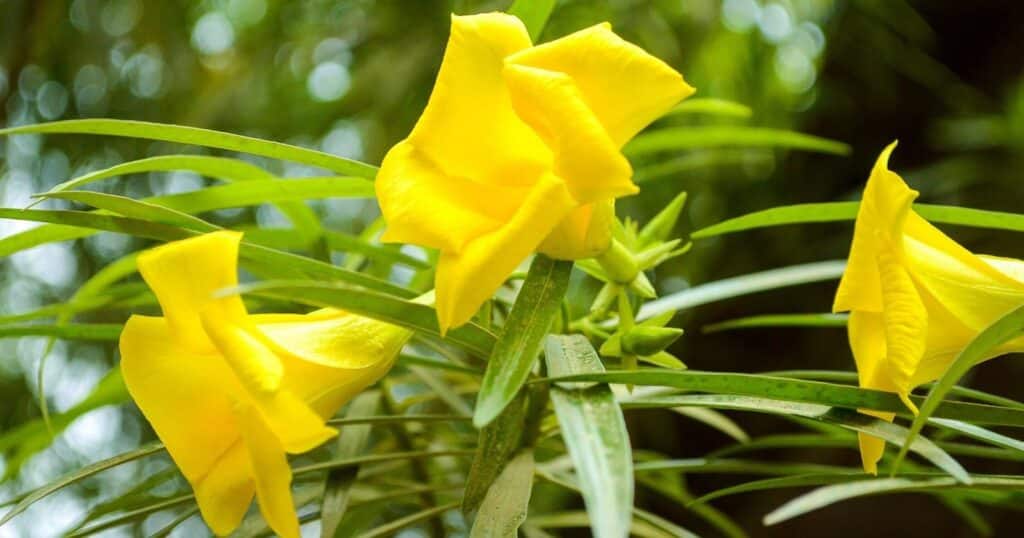
Scientific Name: Cascabela thevetia
- Plant Type: Evergreen shrub
- Geographic Origin: Mexico and Central America
- Plant Size: 7 feet tall
- Sun Exposure: Full sun or partial shade
- Plant Zone: 8-10
Yellow oleanders have an incredibly sweet scent and eye-catching funnel-shaped flowers. This yellow flowering shrub is also called a Lucky Nut, a Dicky Plant, and a Cook Tree. The plant also produces a plum-like fruit with soft flesh.
All parts of the yellow oleander plant are toxic to humans, especially the fruit and its seeds. Several children have died from ingesting species from the oleander family.
This is a thirsty plant that needs regular watering. Extra attention should be paid to hydration during the early spring through early fall.
Yellow Roses
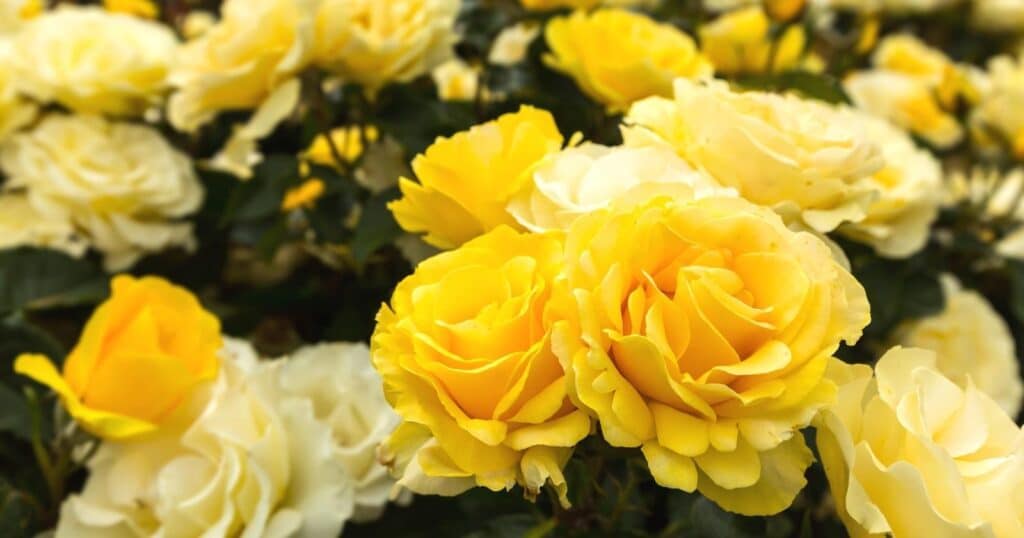
Scientific Name: Rosa foetida
- Plant Type: Perennial flowering shrub
- Geographic Origin: Middle East
- Plant Size: 2 to 3 feet tall and 1 to 2 feet wide
- Sun Exposure: Full sun or partial shade
- Plant Zone: 5-10
There are around one hundred species of shrubs in the rose family. These famous flowers are native to temperate regions in the northern hemisphere and display several different color blooms. You can find white, pink, red, and even yellow roses.
Yellow roses once grew wild in the Middle East. In the 18th century, these wild shrubs gained international popularity that has yet to fade. In modern western cultures, a yellow rose symbolizes love and friendship.
This yellow flowering bush smells wonderful and is sure to add a touch of elegant beauty to any landscape.
Yellow Spice Bush
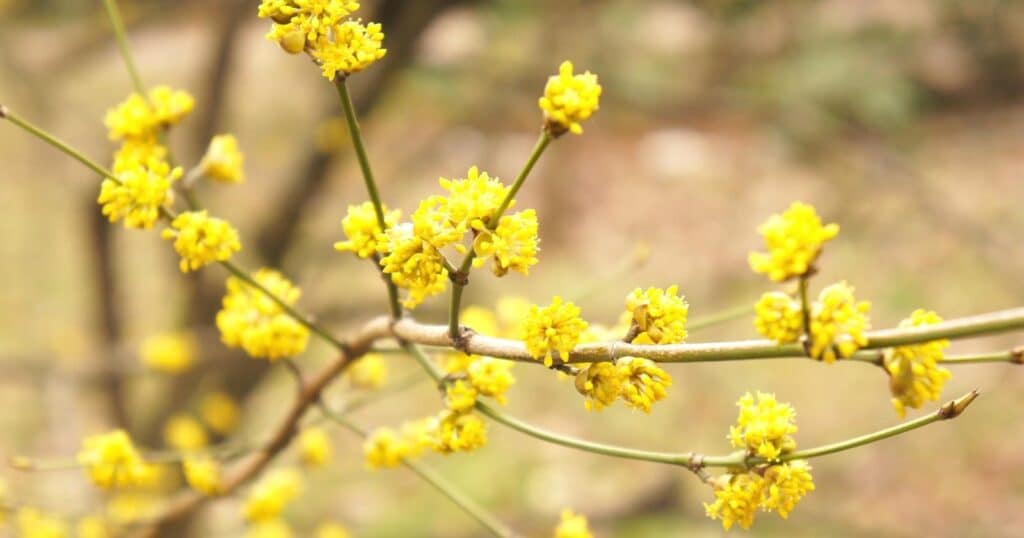
Scientific Name: Lindera benzoin
- Plant Type: Deciduous shrub
- Geographic Origin: Eastern North America
- Plant Size: 4 to 12 feet wide and tall
- Sun Exposure: Full sunlight or partial shade
- Plant Zone: 4-9
The spicebush is an east yellow flowering bush and one of the most fragrant shrubs around. It can be found growing wild in forests, rabies, valleys, and even swamps. It is also called snap bush, wild allspice, fever wood, and spicewood.
The yellow spicebush is a broad shrub with multiple stems that produces yellow-green blossoms in the early spring. The flowers often emerge before the leaves sprout. The bush’s green leaves change to a golden color in the fall.
The distinctive spicy aroma that gave the plant its name fills the air whenever a twig is crushed underfoot. Femal spicebush plants have glossy red berries that are beloved by many bird species. Male spicebushes will not display berries.
Wrap Up
These beautiful shrubs provide bright yellow flowers in your garden. Some of them are evergreen and will bloom year round depending on your hardiness zone. If you choose from the seventeen yellow flowering shrub options listed above, you will surely have a yard full of sunny blossoms in no time at all!

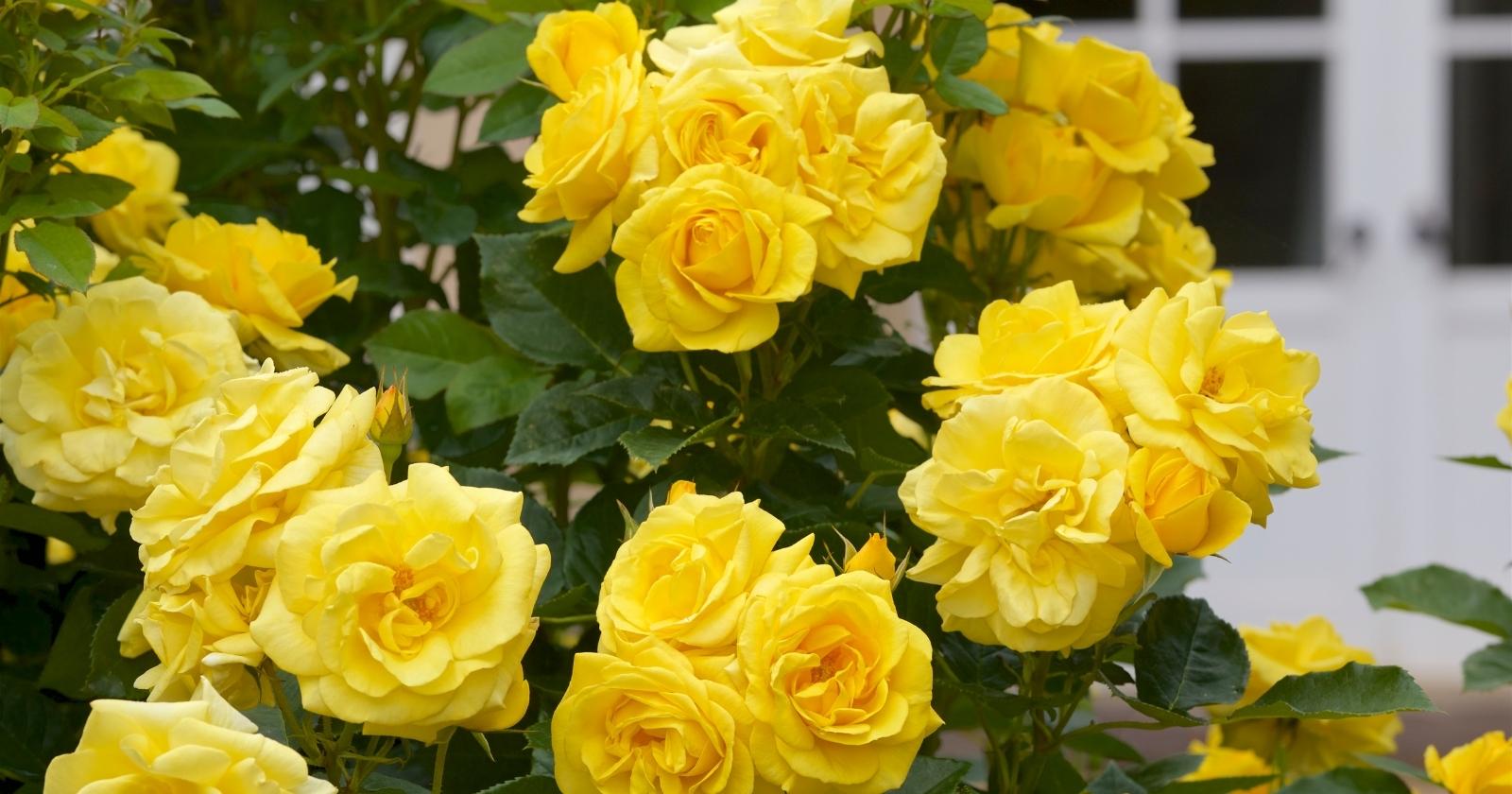
Leave a comment